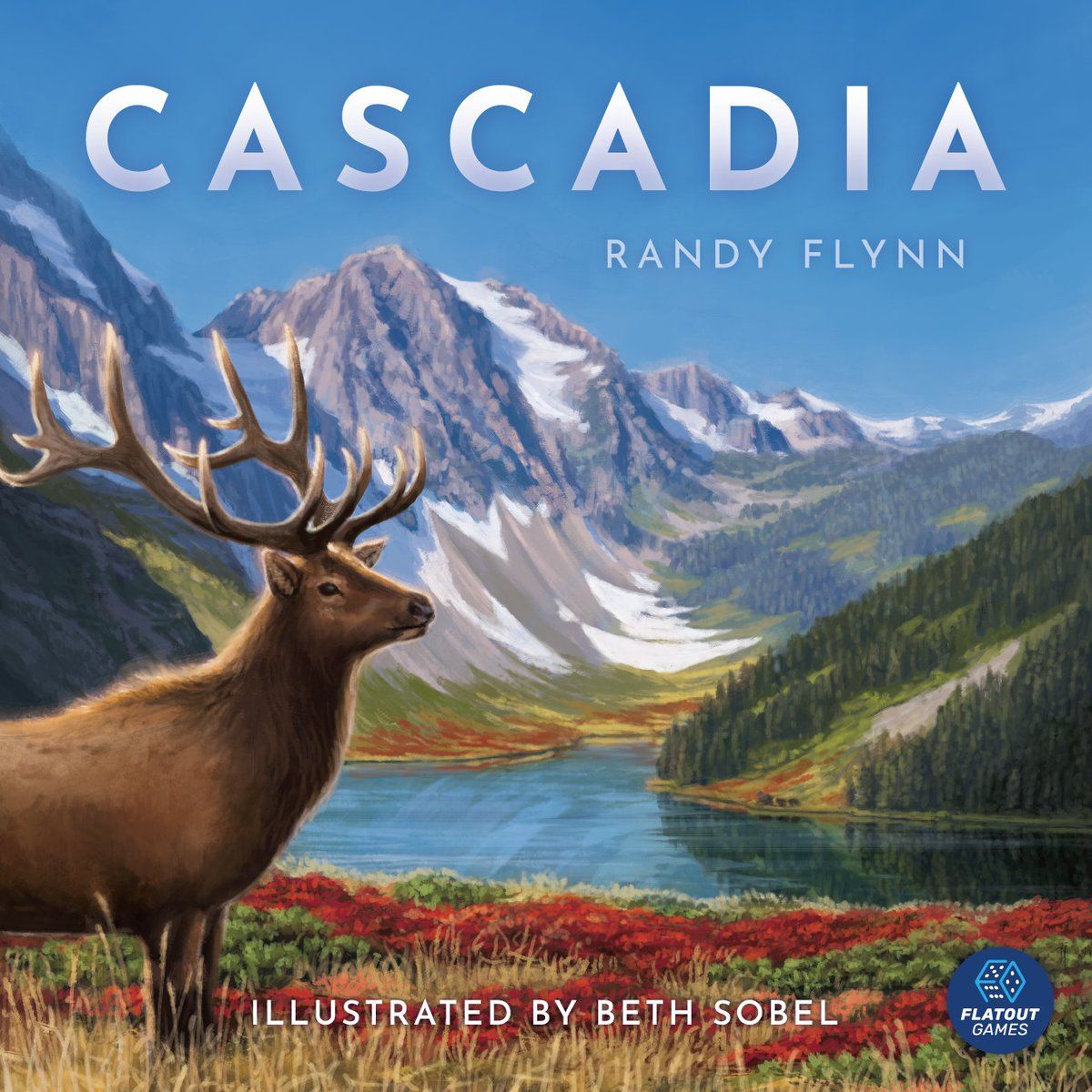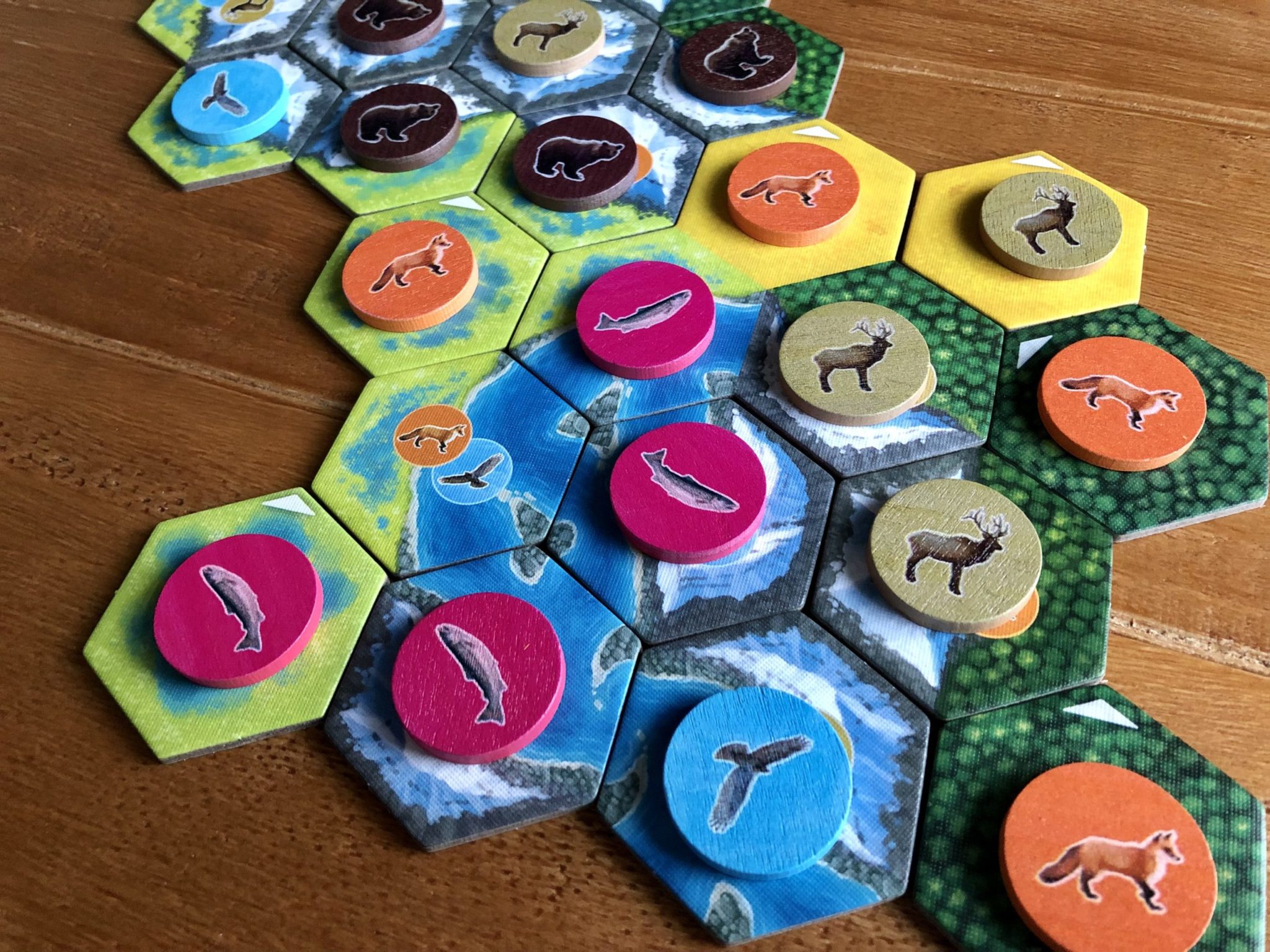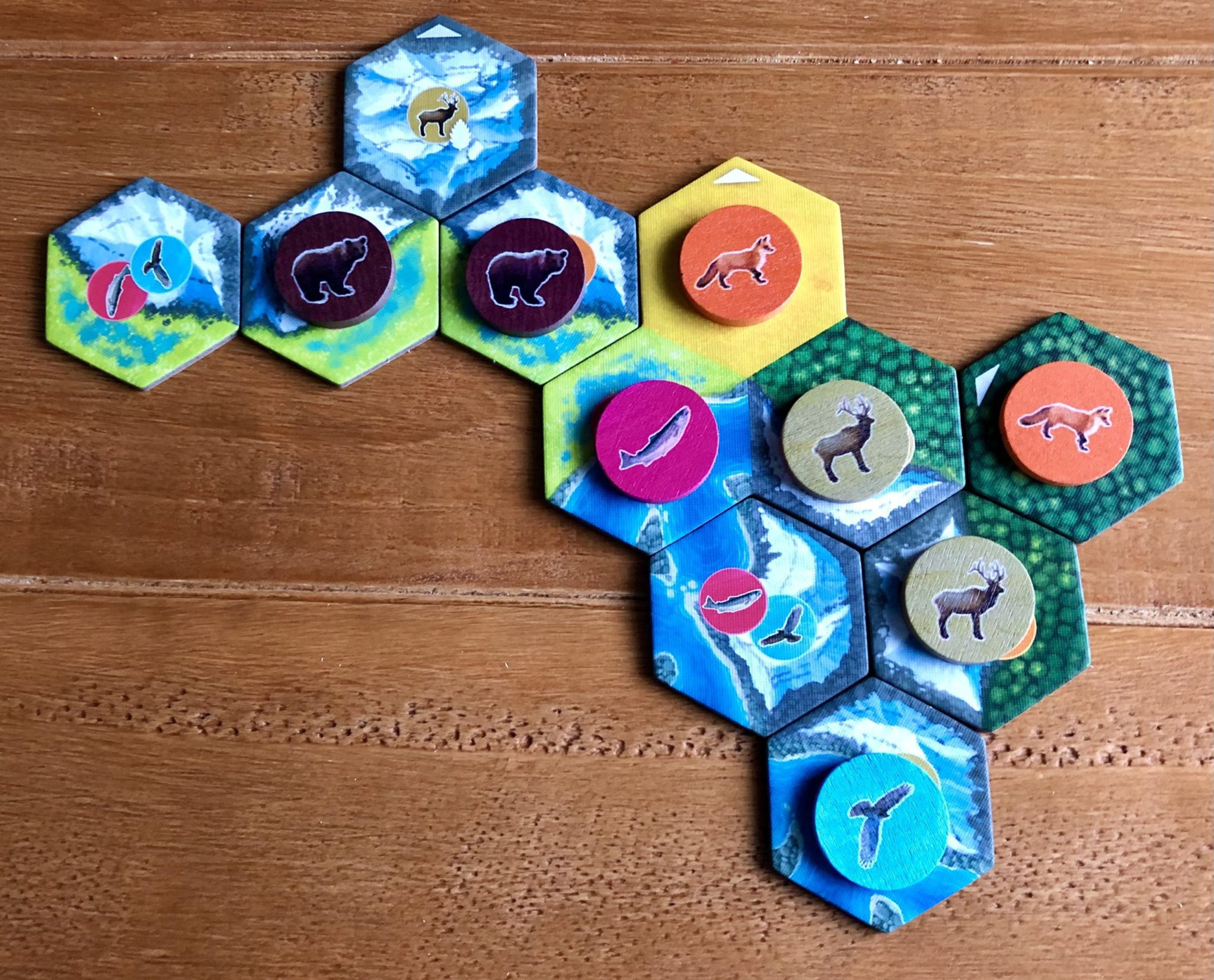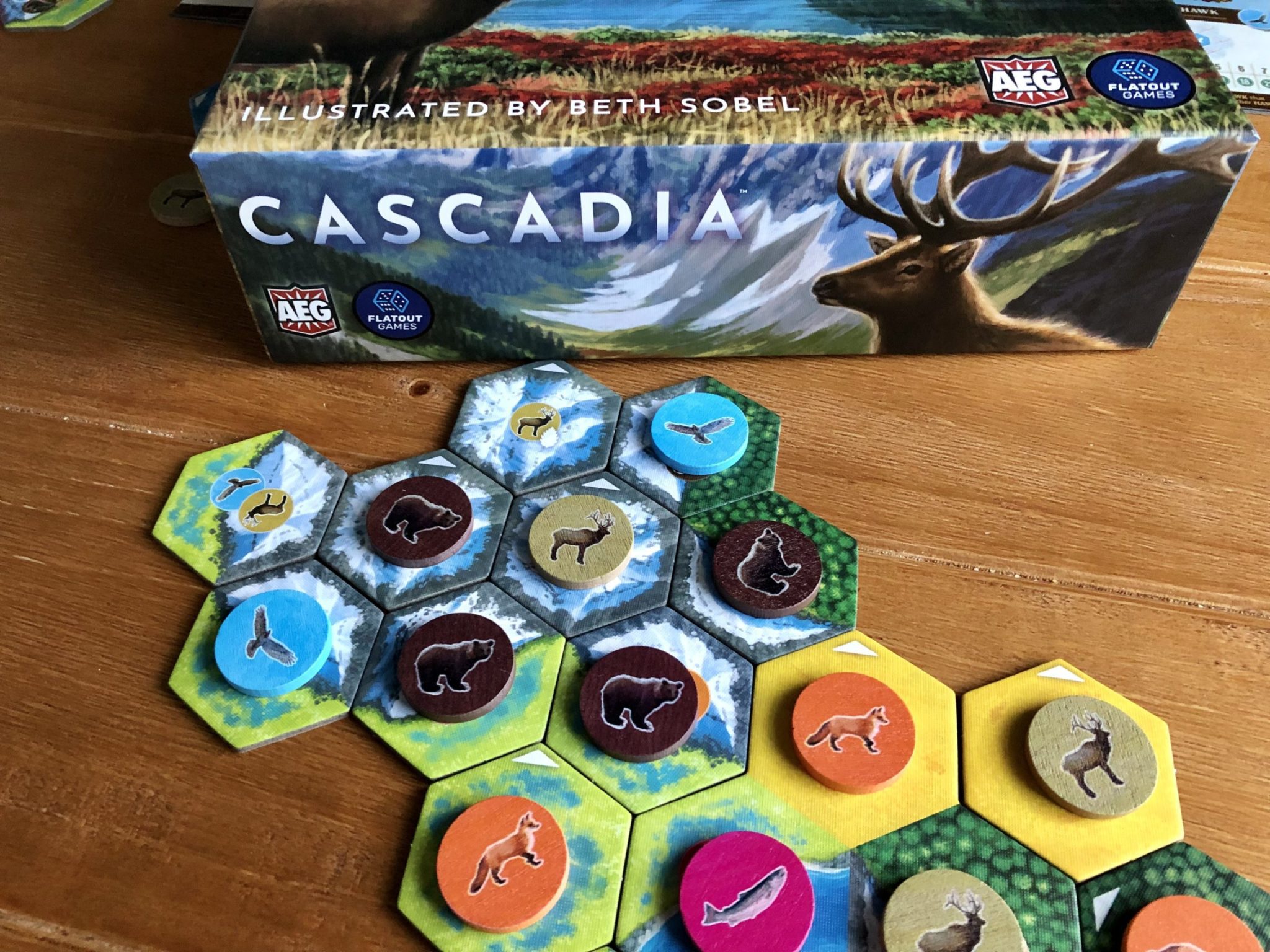Featuring nature and wildlife from the Pacific Northwest, Cascadia is one of Alderac Entertainment Group’s newer family tile laying board game. AEG previously came out with Calico where players placed tiles within a confined space, Tiny Towns which requires planning and strategy, and now we have Cascadia. Like Calico and the party game Point Salad, it’s another game to come from the Flatout Games design collective. Having previously lived in the Pacific Northwest, this game brings back memories and feelings of how beautiful and different this area is compared to others.
What’s in the Box?
- 85 Habitat Tiles
- 5 Starter Habitat Tiles
- 100 Wildlife Tokens
- 21 Wildlife Scoring Cards (4 of each type plus a intermediate card)
- 25 Nature Tokens
- 1 Cloth Bag
- 1 Scorepad

How to Play
Cascadia is a game with surprisingly simple rules. The game is set up with 4 random tiles played out forming a bank of possibilities, each with a random token placed out below it pairing them together. Each player starts with a starter tile which is essentially three tiles placed together. Players take turns by first choosing a tile and token pair to add to their own habitat. The tile is placed anywhere adjacent to another tile. You don’t have to match terrain type at all if you don’t want to, but you definitely want to try to potentially score more points.

The animal token is then placed on any tile in your area that has a matching animal icon. Some of the tiles have more than one icon, but only one animal token can go on each tile. The players refill the center pool with a new tile and a token is drawn at random from the bag. And that’s really it!
Players go back and forth placing tiles and tokens until the tiles run out. At that point players calculate their score and the player with the highest score wins. Even though the rules are super simple, that doesn’t mean the game is simple. The way you score points is what makes this game fun.
There are two main ways to score points. Each animal has a unique way it scores points separate from each other. And don’t worry about having to remember, each animal is highlighted on a card so players can continually check and remind themselves how to maximize points. Salmon like to link together making a salmon run, the Roosevelt Elk form a herd, the foxes like to be next to other animals, and the bears sometimes group together. Each game, a new card changes how an animal scores and the blend of different cards change the way players might play from game to game.

Thee second main way to score points is from the tile placement. Each tile has terrain types depicted on them, which can be placed anywhere in a player’s habitat. Players score one point per tile for your largest contiguous area of the same terrain type. So at a minimum, that’s five guaranteed points, but it will most likely be more than that. Then, the player with the largest contiguous terrain area compared to all others will score additional points. So while playing, players are balancing between placing terrain tiles together and adding animals in areas to score points.
Some of the smaller rules include keystone tiles, which are the tiles with a triangle them, usually featuring one terrain type only. When a player places an animal token on a keystone tile, they receive a nature token. These are used to break the basic rules. You can use it to either take any tile and any token not paired with your chosen tile, or to wipe any number of tokens to replace them with tokens you might want. There is no limit to how many you use per turn but if not used they are worth one point apiece.
In addition, whenever there are four matching animal tokens out, there is overpopulation and all tokens are wiped out and new ones are drawn in their place. If there are three matching animal tokens, the player can choose to either replace them or keep them there. This helps so players aren’t stuck but also creates a tense decision because a player can only wipe tokens once, and then they are stuck with what comes out.

The Verdict
You might hear this all the time, but this is one of the best games that has both simple rules and yet layers and layers of puzzles and strategy. As you have read above, the rules take a couple minutes to understand. You take a tile and token that are linked together and place them in your habitat, trying to place them in a way to score the most points.
While it has some similarities to other tile-placement games you’ve played in the past, there’s a sense of freedom to Cascadia that those lack. You can place your tiles in any direction, since you know you are never shut off from any open edge. This both makes the game easier and harder at the same time. You can find yourself with placement problems, but in Cascadia its usually your own doing. If you tend to focus on many projects and like keeping your options open, eventually you will either forget about a plan and place another tile or animal token in that location or you are forced to create another plan with what you are dealt with.

Cascadia knows that replayability is important in a game. If the game only came with one card for each animal, it wouldn’t be as enjoyable time after time. Carcassonne, a popular tile laying game, tends to be the only exception to this as its has somehow had its success with the same rules every time you play the game. But Cascadia knows that changing these cards just a little bit is much more enjoyable when returning to the game. This also lets players change their strategy to match the game, instead of doing what they would always do in the game to do well.
The art is a highlight, even though there isn’t a whole lot of it. Beth Sobel is known for her work and for me, when just taking a look at the box cover, I know that I will enjoy everything else in the game having to do with her art. The tiles can blend together real well when placing them fluently throughout, but there are couple of places where you have to place an odd terrain in the middle of others. These odd places really stand out and is a little odd to the eye compared to all other tiles that flow together more smoothly.
The components in Cascadia are above average and I appreciate the wooden animal tokens. The game would play almost the same with cardboard tokens, but the wooden tokens really makes the game nicer. The insert is minimal but if you can figure out what the intent is, and setup your insert like it should, it works pretty well for what it is.
As you play the game you will find that your strategy will most likely depend on what the game provides to you during your turn. To do well, you will need to plan on multiple possibilities and not depend on one terrain type or one animal token to come for you to win the game with. Though some games will feed you certain tokens, you have nature tokens that will help you do some finishing touches on your habitat to score those maximum points from a tile and or an animal token that you have the perfect spot for.

Sometimes it can be luck with what your dealt, and many times you just need to change your plans to better fit the current game state for you. But the nature tokens can be very helpful, especially at the end of the game when you can place tokens and tiles in key places to better maximize your points.
Overall this is a very well done tile laying game with some really good replayability from game to game. It’s a multiplayer solo game where you are building your own habitat that no one else can ruin or change. The player interaction consists largely of other players taking tiles or tokens that you need. But players can always help each other to maximize points for each other and enjoy the game more as a team if preferred. Points are not well known, so players won’t know who is winning until the end when the score is tallied up.
Scoring is the most complex aspect of the game and is the key of it being good. The different ways to score will cause you to plan and replan and then re-evluate what your habitat is doing over and over again. You might plan for making a run of salmon, but when tiles or animal tokens don’t come or other tiles and animals come at a better time, you will flip your focus to those and find that you never know what your habitat will truly feature until the end of the game.
Cascadia will find lots of time on our table and will be a game that I will choose to play with new friends, as it displays why board games are so enjoyable.

You can still grab Cascadia as a Late Pledge on the Kickstarter, with the full release at your FLGS on October 1st and Alderac Online Store on October 15th
Images and Review Copy Courtesy of Alderac Entertainment Group
Have strong thoughts about this piece you need to share? Or maybe there’s something else on your mind you’re wanting to talk about with fellow Fandomentals? Head on over to our Community server to join in the conversation!

